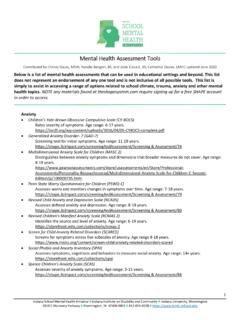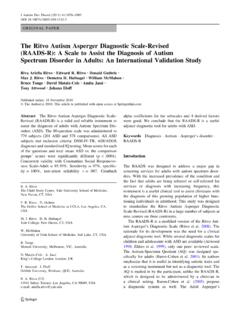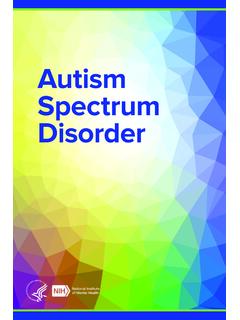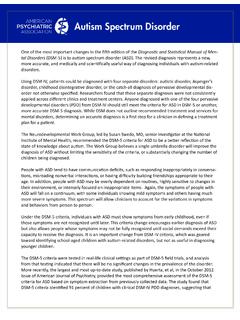Transcription of Reasonable Accommodations for people with Autism …
1 NDA Reasonable Accommodations for people with Autism spectrum Disorder October 2014. Reasonable Accommodations for people with Autism spectrum Disorder June 2015. 1. NDA Reasonable Accommodations for people with Autism spectrum Disorder October 2014. Table of Contents 1. Introduction .. 3. 2. Understanding Autism spectrum Disorder .. 3. 3. Prevalence of Autism spectrum Disorder .. 5. 4. Supports for those with Autism spectrum Disorder- across the 8. Social Skills: social communication, social interaction and social imagination (play) .. 9. Intellectual Function .. 16. Communication and Language .. 18. Attention Span .. 19. Emotional Functions .. 20. General Sensation sensitivity to noise, light, heat .. 21. Sleep Functions .. 22. Control of Voluntary Movement .. 22. 5. Current innovations for people with Autism spectrum Disorder 23.
2 6. Summary .. 24. Activities and Support Groups .. 26. Further reading .. 26. 2. NDA Reasonable Accommodations for people with Autism spectrum Disorder October 2014. 1. Introduction The purpose of this paper is to look at the problems people with Autism spectrum Disorder (ASD) can face and suggest supports that may assist them. It focuses primarily on educational and work environments. The aim of this paper is to inform National Disability Authority guidance. The structure of this paper is as follows: an introduction to ASD including definitions and prevalence rates; a brief description of the difficulties attributed to ASD; and, finally, Accommodations (where available) are identified for each difficulty. Suggested Accommodations are two-fold: Personal coping strategies and Suggestions for educators, employers, carers etc 2.
3 Understanding Autism spectrum Disorder There is considerable disagreement about the exact cause of ASD. It is a neurological condition with three association impairments: social communication, social interaction and social imagination/play. " Autism is a lifelong developmental disability, sometimes referred to as Autistic spectrum Disorder (ASD) or Autistic spectrum Condition (ASC). Its causes are not fully understood, although there is some evidence that genetic factors are involved. The term spectrum ' is used because, while all people with Autism share three main areas of difficulty, their condition affects them in different ways. Some can live relatively independently in some cases without any additional support while others require a lifetime of specialist care."1. people from all socioeconomic groups and nationalities can have There are gender differences as it is more common in boys with a male to female ratio of 4:1.
4 However, it can affect females more Many people with ASD have other behavioural and psychiatric problem, referred to as co-morbidities. These include anxiety, intellectual disability, attention deficit hyperactivity disorder (ADHD)4 and learning difficulties, such as dyslexia (a learning difficulty that makes it difficult for some people to read and write)5 and dyspraxia (a difficulty with coordination as well as planning and carrying out sensory and motor tasks).6 7 8. Deficits in social-information processing can affect perception, understanding, and can limit capacity for understanding others' thoughts, intentions and 3. NDA Reasonable Accommodations for people with Autism spectrum Disorder October 2014. Some medical conditions are also associated with Autism . These include gastrointestinal disorders , seizure disorders and immune disorders such as immune deficiency and dysfunction.
5 10. ASD is a lifelong condition and there is a wide diversity within the spectrum . 11. Deficits will be present throughout the lifespan but how they are presented will vary with age and any other co-morbidities anxiety, sensory difficulties. However, it is important to realise that it is possible to develop strategies to help a person with ASD cope with situations they find difficult and to provide appropriate Accommodations . That is the subject of this paper. The Triad of Impairments people with ASD share three core areas of difficulty. Commonly referred to as the triad of impairments, these include: Social communication (including verbal and non verbal communication). Social interaction (recognising other people 's emotions/feelings and expressing their own)12. Social imagination/play (including engaging in imaginative play and activities).
6 Other related features can include love of routines and rules, aversion to change, and sensory sensitivity for example a dislike of loud noises/bright lights. Around half of people with Autism also have a learning disability while the rest do not. 13. Other conditions classified along the Autism spectrum Disorder have some of the following features: a restricted range of interest abnormal social behaviour including head banging and rocking of body against a solid object poor motor co-ordination speech difficulties and repeating words said by others (echolalia)14. ASD includes closely related disabilities such as: Pervasive developmental disorder - Not Otherwise Specified (PDD-NOS), which refers to a collection of features that resemble Autism but may not be as severe or extensive.
7 Asperger's syndrome, which refers to individuals with some autistic characteristics but relatively intact early language abilities;. 4. NDA Reasonable Accommodations for people with Autism spectrum Disorder October 2014. Childhood disintegrative disorder, which refers to children whose development appears normal for the first few years, but then regresses with the loss of speech and other skills, until the characteristics of Autism are conspicuous, and Rett's syndrome, which affects girls and is characterised by severe progressive physical and mental regression, seizures and some Autism -like features, that become more apparent with 16. DSM V is operational since May 2013. In terms of ASD, the main changes are ASD now includes the previous DSM-IV autistic disorder, Asperger's disorder, childhood disintegrative disorder, and pervasive developmental disorder not otherwise specified.
8 Also, rather than being characterised by a triad of impairments DSM V now defines ASD by 1. Deficits in social communication and social interaction and 2. Restricted repetitive behaviours, interests and activities17 18. There are changes to the age of onset, in that they can be present currently or in reported on in the past. Symptoms for ASD not previously included in DSM-IV. are included, such as sensory issues and fixated interests. DSM-V acknowledges the presence of other medical conditions, such as anxiety, seizures and gastrointestinal problems. Finally, DSM-V includes a new category SCD (Social Communication Disorder). This allows for a diagnosis of a deficit in social communication without repetitive behaviour being present. 19. The ICD 10 (International Classification System) of the World Health Organisation (WHO) classification system defines ASD using the triad of impairment.
9 ICD 11 is due in 2017. If children have a diagnosis of ASD in their early years, they can receive intervention in 21 Barnard et al (2000) believe that early diagnosis and intervention can increase a person's chance of living independently, as well as achieving adequate education and 3. Prevalence of Autism spectrum Disorder The earliest identification of Autism as a specific form of disorder dates from the mid 1940s, and it took a couple of decades before there was more widespread recognition of it as a separate diagnosis. Older adults who may have autistic traits are less likely to have a diagnosis. In recent decades, there has been an increase in the number of children with an ASD diagnosis. Literature suggests changes in diagnostic criteria have affected 5. NDA Reasonable Accommodations for people with Autism spectrum Disorder October 2014.
10 Prevalence 24 There are also dedicated special education resources linked to a diagnosis of ASD in Ireland, which can encourage parents to secure a positive ASD diagnosis for their children. The 2012 HSE review of Autism services also highlights that socio-economic status correlates to prevalence of Autism with increased diagnosis in higher socio-economic groups. This may be ascertainment bias as higher socio-economic groups are in a more favourable position to access better medical help. 25. A report by the Eastern Regional Health Authority (ERHA) reviewing services for people with ASD (2002)26 highlights the difficulty in estimating prevalence rates for people with ASD. This is because of the different methods of "case ascertainment" used. The study points out, that using a tiered approach method generally results in higher prevalence rates for ASD.







